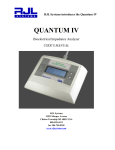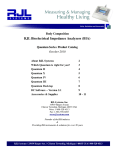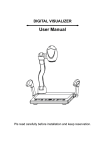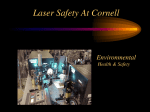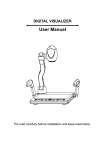Download Quantum II X Manual New Pics.pub
Transcript
QUANTUM II & QUANTUM X BIOELECTRICAL IMPEDANCE ANALYZERS Revision Date November 9, 2007 Table of Contents Proper Care of Your Instrument and Accessories 4 Instrument Do’s 4 Instrument Don’ts 4 Subject Cables 4 Software 4 Replacing the BIA 9-volt Alkaline Battery 5 Storing the Instrument 5 Shipping and Transporting the Instrument 5 Testing of the BIA Instrument 6 When to Test 6 Testing Procedure 7 Potential Causes of “Unusual” BIA or Body Composition Results 7 Electrode Placement, Subject Preparation, and Test Procedure 8 Electrode Placement 8 Subject Preparation 8 BIA Testing Procedure 8 Testing Procedure 9 Operator/Examiner Required Proficiency 9 Frequently Asked Questions 10 Performing the Bioelectrical Impedance Analysis (BIA) Test 10 Validity 12 Equipment 13 Software 14 Ordering and Warranty 15 Proper Care of Your Instrument and Accessories Instrument Do’s: Protect the instrument from physical abuse: like any electronic product, your instrument can be damaged by being dropped, shaken or thrown. Please follow the instructions on page 5 titled: “Shipping and Transporting Your Instrument” when shipping your instrument. Protect from extreme humidity: store the instrument in humidity that does not exceed 90% as exceeding this level may impair its performance. Protect from extreme heat and cold: storing the instrument in conditions that are extremely hot or cold may permanently damage the internal components. Instrument Don’ts: Never eat or drink near the instrument: beverages spilled on the instrument will permanently damage the sensitive electronic equipment of the instrument. Never submerse the instrument in water!! Never disassemble the case: there are no user serviceable parts within the BIA instrument. If you remove the screws that hold the case together, you may damage the static-sensitive circuitry and the batteries. Please note: disassembling the case will VOID your warranty. Subject Cables: The subject cables should be handled with care. 2. When removing the cable from the instrument, pull back gently on the “outershell” or housing (checkerboard appearance) and then pull the cable out of the instrument. 3. Clean the “alligator” clips occasionally with rubbing alcohol to remove potential build up or gel. 1. Software: Take care of the software CD: your software manual came with a plastic CD pocket (back cover). When the CD is not in use, the CD should remain in the holder to avoid potential damage to the disk. “Periodically” perform a back up of the software data: saving databases created by your office is recommended. This will prevent loss of essential patient data in the event something happens to the computer the software is located on. Please note the software name, version and build numbers: the support staff at RJL Systems will need this information to offer assistance regarding software related issues. 4 Replacing the 9-volt Alkaline Battery When the Quantum battery is weak, decimal points will be displayed on the impedance meter, for example: 5.0.0. When this occurs, the results will not be accurate until the battery is changed. Therefore, prior to testing with the Quantum, replace the battery with a new 9-volt alkaline battery and test the analyzer with the 500-ohm test resistor as described in Testing or Calibration of the BIA Instrument on page 5. Storing an Instrument Quantum II and Quantum X: 1. Disconnect the subject cables from the instrument. 2. Store inside the carrying case in a dry, cool environment. Shipping and Transporting an Instrument 1. DO NOT RETURN THE INSTRUMENT TO RJL SYSTEMS WITHOUT PRIOR AUTHORIZATION FROM RJL SYSTEMS. The majority of problems can be solved over the phone. (See Testing or Calibrating the BIA instrument) However, if the instrument does need to be returned, a Return Merchandise Authorization (RMA) number will be issued. Please include the RMA number on the return package. Instruments sent in without a RMA number may NOT be serviced. 2. Place the instrument in its original packing material, if possible. The instrument is fragile and should not be exposed to unnecessary abuse. 3. In the event the instrument needs to be returned to RJL Systems, ALWAYS include the subject cables so that the entire system may be checked. 4. Send the instrument to: RJL Systems, Inc. 33939 Harper Avenue Clinton Twp., MI 48035 5 Testing the BIA Instrument When to Test: The BIA instrument should be tested with the 500 ohm test resistor: 1. 2. 3. 4. 5. When the battery is replaced. When the BIA technician believes the BIA measurements are unusual. When the subject cable may have incurred damage. Prior to a large number of tests for a study. RJL Systems customers have tested or calibrated their instruments: a. Prior to every test. b. At the beginning of a testing day. c. Once a week. d. Once a month. e. Once a quarter. f. After storage. Please note: Tests that need to be retested due to calibration issues could be eliminated with the calibration test. It will not cause any problems to test or calibrate the instrument frequently. 6 Testing Procedure The following steps will test the impedance circuitry, the subject cables, the subject cable connector and the battery: 1. First make sure the instrument has a new 9-volt alkaline battery, if necessary. 2. Attach the 500 ohm test resistor (located in the plastic test tube), as shown in the diagram above. 3. Turn the instrument on and note the resistance value displayed. (The test resistor should not be held by the technician during testing or calibrating, to ensure proper measurement of readings.) The resistance value should be between 495 and 505 ohms. Then switch the instrument to the reactance measurement. The reactance value should be –003 to 003. Readings inside these ranges indicates that the impedance circuitry is in good working order. 4. To check the subject cable: a. Verify that the connector is completely inserted in the instrument. b. Turn the instrument on and put it in “Resistance” mode. c. Move the cables, gently, up and down the whole length of the cable, especially near the end of the blue portion of the cable and right at the clips. Please note: if there are unusual jumps in the resistance reading while performing this test, there is probably a break in the cables and you should replace the cables. For example, the resistance value starts at 499 and while moving the cables it jumps to 283. If all the previous steps were performed with good results, your BIA instrument and cable are working properly. In the event results were not within the acceptable ranges, contact RJL Systems and speak with someone in the service department. Please have your results available or be prepared to run these tests again, when you call. Potential Causes of “Unusual” BIA or Body Composition Results 1. 2. 3. 4. 5. 6. 7. 8. A malfunctioning BIA instrument. ( See “Testing the BIA Instrument” on page 6 ) Damaged subject cables. ( See “Testing the BIA Instrument” on page 6 ) Expired adhesive electrodes. ( RJL Systems adhesive electrodes have an average shelf life of 15 months. ) Subject in contact with a conductive (metal) table while testing. ( See “BIA Testing Procedure” ) Subject has recently used lotion at the electrode placement sites. ( See “BIA Testing Procedure” ) Error in data entry of subject information into body composition software a. Gender incorrect: male vs. female b. Weight number transposed: 158 vs. 185 c. Height input as feet instead of inches: 5’6” typed 56 vs. 66. d. Height or weight entered in “English” units when the drop-down is set to “Metric” (or vice-versa). Subject did not follow protocol instructions. ( See “Subject preparation” on page 8 ) Low Battery. ( See “Replacing the 9-volt Battery” on page 5 ) 7 Electrode Placement, Subject Preparation and Test Procedure Electrode Placement Subject Preparation The subject should not have exercised or taken a sauna within 8 hours of the test. The subject should refrain from alcohol intake for 12 hours prior to the test. The subject’s height and weight should be accurately measured and recorded. The subject should not be moist from sweat or lotion. The subject should not have a fever or be in shock. The subject’s height and weight should be accurately measured and recorded. The study and testing procedure should be explained to the subject. BIA Testing Procedure The exam area should be comfortable and free of drafts and portable electric heaters. The exam table surface must be non-conductive and large enough for the subject to lie supine with the arms 30 degrees from the body and legs not in contact with each other. The Quantum analyzer should have a new 9-volt battery. The analyzer calibration and patient cables should be checked regularly. 8 Testing Procedure The subject should remove the right shoe and sock (generally the study is completed on the right side of the body). The body side (left or right) should always be used subsequently. The subject should lie supine with the arms 30 degrees from the body and legs not touching and remove jewelry on the electrode side. The electrode sites may be cleaned with alcohol, particularly if the skin is dry or covered with lotion. Attach the electrodes and patient cables as shown in the illustration. Turn the analyzer on and make sure the subject refrains from moving. When the measurements have stabilized, record the displayed Resistance (R) and Reactance (Xc) with the subject’s name, age, gender, height and weight. Remove and dispose of the electrodes, be careful not to injure the subject’s skin or contaminate the operator. The entire testing time is less than 5 minutes—the BIA analyzer is on for less than one minute. The results are available immediately from the software program. The study may be repeated as often as necessary. Operator/examiner must demonstrate the following level of proficiency: Two consecutive measurements made on a single, stable subject must result in Resistance values within one percent of each other. 9 BIA Frequently Asked Questions (FAQ) Table of Contents: I. II. III. IV. V. I. Performing the Bioelectrical Impedance Analysis (BIA) Test Validity Equipment Software Ordering & Warranty Performing the Bioelectrical Impedance Analysis (BIA) Test Should the test subject lie down to be tested? All research has been performed with the subject lying flat with legs apart and arms not touching the body, therefore it is recommended that the test subject lie down to be tested. What side of the body is used for BIA testing? The right side of the body is commonly used for BIA testing. However, the left side of the body may be used if necessary. It is important to be consistent and use the same side on a test subject for repeatability. Can you feel the test while it is being performed? No, the current passed through the body is so small that it is unlikely it will be felt at all! How long does it take to perform a BIA test on a subject? Typically, the test will take approximately five minutes. What electrodes can be used for testing? RJL Systems, Inc. (RJL) suggests that the tests be performed using the adhesive electrodes supplied by them. RJL cannot guarantee accurate test results acquired by using other electrodes. Do I have to use new electrodes for every test subject? Yes, for accuracy, and above all, for sanitary reasons, new electrodes should be used for each test performed. Can the age of electrodes affect results? Yes, RJL electrodes have a shelf life of 14 to 16 months. Expired electrodes will produce inaccurate results. As well, if electrodes are not kept in a sealed bag or container, they can dry out and also produce inaccurate results. 10 Is there anything particular that the test subject should do prior to being tested with the RJL Analyzer? The test subject’s body should be dry; no fever should be present, and should not be chilled or cold. Please review “Subject Protocol” on the “Electrode Placement” card. Could very dry or very oily skin affect the BIA readings? Yes. Good contact between the skin and electrodes must be made for accurate results. If a person’s skin is oily, wipe the area with an alcohol swab before positioning the electrodes. If the skin is very dry, use an electrode gel. Do women have to remove their nylons before testing? Yes, the adhesive electrodes must make direct contact with the skin for an accurate measurement. Will jewelry affect the BIA test? No, there will be no affect on the BIA test provided the jewelry does not interfere with electrode placement. However we recommend that all jewelry be removed. Do pins in a subject’s arms or legs affect the BIA readings? No, pins in a subject’s arms or legs will not affect the BIA readings. Can people with pacemakers be tested with the RJL analyzers? No, people with implanted electronic devices such as pacemakers or defibrillators should NOT be tested due to the possibility of interference of the BIA signal with the defibrillator. Will medication affect the reliability of the BIA test? Changes in the results may come from medications, disease and nutritional status. BIA results quantitatively illustrate all of these factors and conditions. That's what BIA is all about! Can obese or emaciated test subjects be tested with the RJL analyzers? Yes, and serial testing will reflect changes in a person's body composition. Can pregnant women be tested with the RJL analyzers? No. At what age can children be tested? Equations were developed on children beginning at age 8. However, people of any age may be tested for resistance and reactance results. 11 Are medical professionals the only people that should perform the BIA test? No, anyone that has been properly trained can perform the test. Once trained, a technician should be able to retest a patient (changing electrodes) to within a 1% difference in the resistance reading. What is the average amount charged for a BIA test? $15.00 charge at a health fair and $25.00 to as high as $150.00 for a test done in other environments. The price will depend on the location and the degree of professional consultation. How often should the test be performed? This would depend on your facility and your client. The average professional generally tests every four to six weeks. How could the RJL analyzer be useful in my everyday practice? Examples would be a post delivery weight reduction program in an OBGYN setting or lifestyle change in a wellness setting. II. Validity How does bioelectrical impedance analysis work? Please visit our website for an explanation: http://rjlsystems.com/docs/bia_info/ fundamentals/. What is resistance, reactance, and phase angle? Please visit http://rjlsystems.com/docs/bia_info/principles/ for an explanation of resistance, reactance, and phase angle. Is it possible to have too little body fat? Yes, your body needs some fat for energy storage and normal metabolic functions. Does RJL have software specific to nationality? No, because race, gender and disease do not affect the repeatability of the results. How and why does dehydration affect the BIA test? Changes in hydration are proportional to changes of extracellular water and, therefore, affect the absolute volume of fat free mass and fat. However, weight is also changing proportionally; when fat or fat free mass is expressed as a percent of weight, the results should be consistent. 12 Is it possible for a person to drink too much water prior to being tested? No, it is nearly impossible for a healthy individual to become over hydrated. Drinking a lot of water immediately before being tested will not affect the accuracy of the test, as all the water will be in the trunk area only and not dispersed throughout the body. It will take a dehydrated person's muscles at least several hours to absorb the water. Have the RJL analyzers been tested on any animals? Yes, they include: cats, dogs, fish, cows, elk, seals, polar bears, grizzly bears, orangutans, pigs, lambs, moose, deer, rats and mice. Please visit our website: http://rjlsystems.com/docs/animals/ for more information. III. Equipment How long has RJL been manufacturing BIA analyzers? RJL has been manufacturing BIA analyzers since 1979. How will I know if my RJL analyzer is operating correctly (calibrated)? A 500-ohm resistor is included with all the RJL analyzers. This resistor allows you to check the calibration of the analyzer. For an explanation on how to test the calibration of your unit, please refer to page 6 of this manual. Is there any chance of electrical shock while operating the RJL analyzers? No, all of the RJL analyzers are designed with isolation transformers that prevent any harmful current from being exposed to the subject while being tested. How do I know when the BIA instrument needs a new battery? A line of decimal points will appear at the bottom of the LCD screen. Will climate affect the BIA test? Yes, but only when climate changes are extreme. Is the RJL equipment FDA approved? The Food and Drug Administration regulates all BIA devices as class II medical devices. Manufacturers must receive clearance from the FDA to market a class-II device. Please visit the FDA website for more information on RJL registration and clearances. http://www.accessdata.fda.gov/scripts/cdrh/cfdocs/cfRL/listing.cfm? ID=14066 or http://www.accessdata.fda.gov/scripts/cdrh/cfdocs/cfPMN/pmn.cfm. (Search for “RJL Systems” under Applicant Name or Owner Name.) 13 What is the difference between the Quantum II analyzer and the Quantum X ? The differences between the two units are resolution The Quantum II has a resolution to 1.0 Ohms and the Quantum X has a resolution to 0.1 Ohms., or ten times that of the Quantum II. Both the Quantum II and the Quantum X are hand held analyzers that weighs 11 oz., and run on a 9-volt battery (ONLY). Neither system stores data nor do they have serial communication capability. All RJL BIA instruments test with equally accurate resistance and reactance results, and all RJL BIA results can be entered into the our current software for body composition analysis. What is the life expectancy of an RJL analyzer? It is many years, so long as you take care of your analyzer. RJL still has many of their customers (from as far back as 1980) using their originally purchased analyzers. However, with any type of equipment, the age of the instrument may affect reliability. As a result of continual use, parts may wear out and need replacement. Are the RJL analyzers very difficult to operate? No, anyone can operate the RJL analyzers. It is helpful, however, to read the supplied manual first. IV. Software What are the minimum system hardware requirements to run the RJL Systems body composition software? Windows 95/98/NT 4.0/2000/ME/XP 800 x 600 x 256 color screen setting 30 MB of disk space – minimum 32 MB Memory (recommended 64 MB Memory) 133 MHz Pentium Processor or equivalent (recommended 300 MHz Pentium-II Processor or equivalent) Microsoft Internet Explorer 4.0 or greater (recommended Microsoft I.E. 5.5 or greater) What are the system software requirements to run RJL software? To run the RJL software, your system must have Windows 95 or higher. What programming language is RJL software written in? Our software is written in the Perl language. If you have a copy of Perl installed on your computer, the RJL software may have issues. Please contact RJL for details. For specific software questions please feel free to contact RJL at 1-800-528-4513 or visit our web site at www.rjlsystems.com for information regarding our software. 14 V. Ordering & Warranty How would I go about placing an order? To order supplies, contact RJL Systems. Call 1-800-528-4513 Order online at www.rjlsystems.com. Fax your order to 1-586-790-0205 You can contact our sales department in any of the following ways: Call 1-800-528-4513 E-mail our sales department at [email protected]. Fax a request for a quote to 1-586-790-0205* *Please indicate in your fax, if you would like the quote to be mailed or e-mailed to you, or if you require personal assistance. Fill out our Information Request Form on our website and we will contact you. What methods of payment are acceptable when I place an order with RJL Systems, Inc.? Orders must be placed directly with RJL at 33939 Harper Avenue, Clinton Twp., MI 48035. Terms include: Visa, MasterCard, AMEX, C.O.D. (U.S. orders only), Check or Purchase Order (restrictions apply – call for details), or wire transfer. Can I place an order and have it shipped someplace other than my billing address? Yes, all of the RJL analyzers and products may be shipped directly to anywhere in the world. All such shipments must be paid for prior to delivery via wire transfer, Visa, Mastercard or American Express or receipt of check. RJL is not responsible for custom and duties charges or issues. Does RJL supply a service manual (complete with schematics) to a government agency whose bioengineering department requires this information? Yes, RJL may release the service manuals (complete with schematics) to major universities, hospitals, etc. ONLY. An original company non-disclosure contract must be signed prior to the release of this information; the requested information is proprietary to RJL Systems, Inc. What is and is not covered by the RJL Warranty? Parts and service (labor) on the BIA unit is covered for one year. Return shipping within the US and Canada is covered for a period of one year. Cables, such as power cords and subject cables, are not covered by the warranty. Extended warranties are available. 15

















